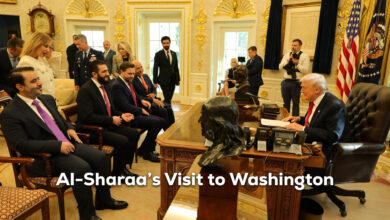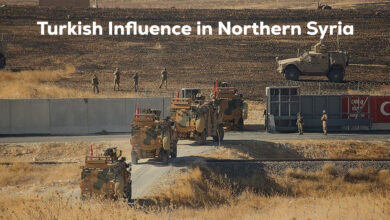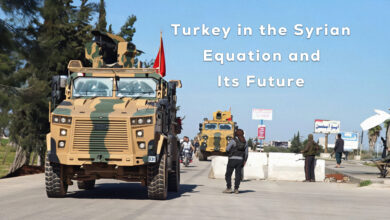Syria’s future… expectations and connotations
In light of the international and regional changes, the Arab capitals witnessed movement and openness towards the Syrian regime, including the United Arab Emirates (UAE), Oman, Jordan, Iraq, and other Arab countries, especially after the earthquake that struck both Syria and Turkey, and humanitarian and relief aid poured into Damascus from various countries, especially the Arab ones. This was accompanied by political visits by Syrian President Bashar al-Assad to the UAE, Oman, and Russia, followed by meetings and statements regarding the Turkish withdrawal from the occupied Syrian territories, then the quadripartite meetings that included Russia, Turkey, Iran, and Syria at the level of defense and security intelligence ministers of the aforementioned countries, all the way to meetings at the level of foreign ministers for electoral reasons in favor of Turkey and Erdogan, which only bore fruit in some snapshots that brought together Faisal al-Mekdad, Syria’s Foreign Minister, and his Turkish counterpart Mevlut Cavusoglu. Then, followed by the movement, the Arab role, the Amman meetings, and the meeting in Jeddah and Cairo, in preparation for the return of Syria to the Arab League, and then the meeting of the Arab leaders at the Jeddah Summit, in which the Syrian president delivered his speech on loyalty and embrace, praising Arabism that he uses as an umbrella from time to time.
Among the reasons for attracting Syria to the Arab fold is the emergence of many problems that have had negative effects on Arab countries, such as border security problems between Syria and Jordan, drug smuggling and manufacturing in Syria in cooperation with the Lebanese Hezbollah and the Iranian Revolutionary Guard militias in Syria, claiming that they are advisors to the Syrian forces, and Captagon manufacturing sites, smuggling and distribution that are present on the border between Syria and Lebanon in the areas of the Qalamoun Mountains, with a length of approximately 80 km and a depth of 10 km, which are controlled by the Lebanese Hezbollah in cooperation with Syrian authorities that may affect the commander of the Fourth Division forces, Maher al-Assad, the brother of the president. These drugs leak across the Jordanian border to Saudi Arabia and the Gulf states and threatens their security and stability. It is an attempt by the Arabs to resolve this issue through the Arab summit and compel Syria to implement it in exchange for providing aid and money to Syria and subsidizing it from the Kingdom of Saudi Arabia and other Gulf countries, led by the UAE.
In addition, another problem that the Arab countries wanted to get rid of, which caused embarrassment and pressure on the Arab countries, is the problem of the safe return of Syrian refugees to their homeland. The Arab countries, such as Egypt, Sudan, and the rest of the Gulf countries, have not shown any willingness or welcome to them since the beginning of the Syrian crisis, and this is evidence that they were more concerned with the stability of their countries and their conditions than issues of nationalism, brotherhood, Arabism, and others, and this issue the Syrian regime wants to extort from the Arab countries in order to obtain large financial aid under the pretext that most of their areas need reconstruction and infrastructure preparation, especially in areas that have been subjected to vandalism, bombing, and destruction, and then the Syrian regime relies a lot on the issue of reconstruction and obtaining the support of Arab and Gulf countries, and this was stated by the Syrian Assistant Foreign Minister Ayman Soussan, who hoped that the Arab countries should immediately begin reconstruction and provide financial assistance. Syria also hopes that the balanced Arab countries will help in lifting the economic sanctions imposed on Syria by the United States and the European Union, and exert pressure in favor of lifting them on Syria, such as the Caesar Act, which the US seeks to expand as well. It [the US] also wants to issue the normalization law that targets countries that are still seeking and continuing to normalize with the Syrian regime.
As for the solution to the Syrian crisis, which was linked to UN Resolution 2254, it is likely that this was the last concern of the Arab countries whose security and economy are preoccupied in the first place and their influence and continuity and survival in the rule of their regimes, and this includes most of the Arab countries, including the Syrian regime itself, which is well aware of this issue, and the most likely will not comply with this international and UN resolution even if not a single Syrian remains in the country. This is inferred by the Iranian president’s visit to Syria a few days before the Arab summit in Jeddah, in which he visited Shiite gathering places in Damascus, such as the city of Sayyidah Zaynab, and delivered a speech about Syria and its strategic cooperation which culminated in many agreements and understandings that included most of the service and economic sectors in Syria, such as ports, airports, electricity, oil and phosphates, and the purchase of lands that amounted to more than tens of hectares. It also included the expansion of Shiite religious shrines in Damascus and Aleppo, such as the shrine of Sayyidah Ruqayya Shrine in the al-Amara neighborhood in Damascus that amounted 6,000 meters under the pretext of collecting Iranian debts on Syria, which amounted to more than 30 billion dollars. These Syrian-Iranian understandings are an affirmation of Iran’s participation in reconstruction and an affirmation of the Iranian role in Syria, as if it were a message to the Arab summit that was held in Jeddah, and it is also an affirmation of the superficiality of Syria’s participation and role. The Syrian regime is not independent and is dependent on the Iranian and Russian regimes. Therefore, the decisions of the Arab summits from Amman, Cairo, and Jeddah regarding curtailing Iranian influence are a mirage with no real effectiveness on it.
As for the issue of the withdrawal of foreign forces from Syria, this is difficult to achieve in the near future, as Syria is occupied and influenced by many foreign countries. Israel occupies the Golan Heights and launches air and military strikes targeting Iranian warehouses, sites, and airports, and Turkey occupies northern Syria from Idlib, Afrin, Ras al-Ain, Tel Abyad, and others, and it launches drone attacks from time to time and expands and closes the crossings by their allies in the Kurdistan Region of Iraq and besieges the refugee camp in Makhmour, and they have not yet decided the issue of their presidential election, and the Iranian influence is widespread in the rest of the western regions of Syria and its cities, and it justifies its presence in Syria with the approval of the Syrian regime as an ally and friend. While the Russian influence in the Syrian ports such as Tartus and in Khmeimim, is at the invitation of the Syrian state, as they claim. As for the US, it is present in northeastern Syria and is allied with the Syrian Democratic Forces (SDF) against ISIS and terrorist organizations, and it has the main role in supporting the Autonomous Administration and striking sleeper terrorist cells from time to time, as happened with the suppression of ISIS in al-Sina’a prison in Hasakah, and the terrorist cells in al-Hawl camp despite Turkey, Russia, Iran, and the Syrian regime’s opposition to the American presence in northeastern Syria, it is America that seeks to find a solution to the Syrian crisis through its decisions and sanctions against the Syrian regime, and does not object to any initiatives to find solutions to the Syrian crisis. It also welcomed the initiative of the Autonomous Administration, which sought to reach a comprehensive settlement with the Syrian regime included the unity of the Syrian territories and included the distribution of wealth to all Syrians, which refuted all malicious accusations against Turkey and other hostile regimes, and the Autonomous Administration calls for changing the Syrian constitution and making decentralization a basis for all regions in Syria, and there are also leaks about Syrian-American meetings in Oman in which the US confirms the need for the SDF to participate in resolving the Syrian crisis, and there are leaks about an Arab-Emirati role to bring the views of the Syrian regime and the Autonomous Administration closer.
One should say that the Syrian president is not serious about returning to the League and the Arab ranks except to the extent that he tries to benefit from Arab support to sow blood in his veins, and to preserve his Russian and Iranian allies. Also, his decision depends on them, especially for the latter mentioned, and the Syrian regime is close to agreeing on the administration’s initiative. However, he is procrastinating to obtain more concessions and leaves it to Turkey to exercise as much damage as it can and exert pressure by blackmailing the US to gain more Syrian lands, and Turkey’s turn with the regime is nothing but a political maneuver to win the elections, so everyone is watching and waiting for the changing future.




